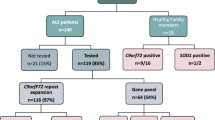Abstract
Amyotrophic lateral sclerosis (ALS) is characterized by degeneration of upper and lower motor neurons. The hexanucleotide repeat expansion in C9orf72 gene (C9orf72-HRE) is the most frequent genetic cause of ALS. Since many ALS pedigrees showed incomplete penetrance, several genes have been analyzed as possible modifiers. Length of the GCG repeat tract in NIPA1 (non-imprinted in Prader-Willi/Angelman syndrome 1) gene has been recently investigated as a possible modifier factor for C9orf72-HRE patients with contrasting findings. To disclose the possible role of NIPA1 GCG repeat length as modifier of the disease risk in C9orf72-HRE carriers, we analyzed a large cohort of 532 Italian ALS cases enriched in C9orf72-HRE carriers (172 cases) and 483 Italian controls. This sample size is powered (92% power, p = 0.05) to replicate the modifier effect observed in literature. We did not observe higher frequency of NIPA1 long alleles (> 8 GCG) in C9orf72-HRE carriers (3.5%) compared with C9orf72-HRE negative patients (4.1%) and healthy controls (5%). For the latter comparison, we meta-analyzed our data with currently available literature data, and no statistically significant effect was observed (p = 0.118). In conclusion, we did not confirm a role of NIPA1 repeat length as a modifier of the C9orf72 ALS disease risk.
Similar content being viewed by others
References
Chia R, Chiò A, Traynor BJ (2018) Novel genes associated with amyotrophic lateral sclerosis: diagnostic and clinical implications. Lancet Neurol 17(1):94–102. https://doi.org/10.1016/S1474-4422(17)30401-5
Ji AL, Zhang X, Chen WW, Huang WJ (2017) Genetics insight into the amyotrophic lateral sclerosis/frontotemporal dementia spectrum. J Med Genet 54(3):145–154. https://doi.org/10.1136/jmedgenet-2016-104271
Blauw HM, van Rheenen W, Koppers M, Van Damme P, Waibel S, Lemmens R et al (2012) NIPA1 polyalanine repeat expansions are associated with amyotrophic lateral sclerosis. Hum Mol Genet 21(11):2497–2502. https://doi.org/10.1093/hmg/dds064
Tazelaar GHP, Dekker AM, van Vugt JJFA, van der Spek RA, Westeneng HJ, Kool LJBG, Kenna KP, van Rheenen W, Pulit SL, McLaughlin RL, Sproviero W, Iacoangeli A, Hübers A, Brenner D, Morrison KE, Shaw PJ, Shaw CE, Panadés MP, Mora Pardina JS, Glass JD, Hardiman O, al-Chalabi A, van Damme P, Robberecht W, Landers JE, Ludolph AC, Weishaupt JH, van den Berg LH, Veldink JH, van Es MA (2018) Association of NIPA1 repeat expansions with amyotrophic lateral sclerosis in a large international cohort. Neurobiol Aging 74. https://doi.org/10.1016/j.neurobiolaging.2018.09.012
Dekker AM, Seelen M, van Doormaal PT, van Rheenen W, Bothof RJ, van Riessen T et al (2016) Large-scale screening in sporadic amyotrophic lateral sclerosis identifies genetic modifiers in C9orf72 repeat carriers. Neurobiol Aging 39:220.e9–220.15. https://doi.org/10.1016/j.neurobiolaging.2015.12.012
van Blitterswijk M, Mullen B, Heckman MG, Baker MC, DeJesus-Hernandez M, Brown PH, Murray ME, Hsiung GYR, Stewart H, Karydas AM, Finger E, Kertesz A, Bigio EH, Weintraub S, Mesulam M, Hatanpaa KJ, White CL III, Neumann M, Strong MJ, Beach TG, Wszolek ZK, Lippa C, Caselli R, Petrucelli L, Josephs KA, Parisi JE, Knopman DS, Petersen RC, Mackenzie IR, Seeley WW, Grinberg LT, Miller BL, Boylan KB, Graff-Radford NR, Boeve BF, Dickson DW, Rademakers R (2014) Ataxin-2 as potential disease modifier in C9ORF72 expansion carriers. Neurobiol Aging 35(10):2421.e13–2421.e17. https://doi.org/10.1016/j.neurobiolaging.2014.04.016
DeJesus-Hernandez M, Mackenzie IR, Boeve BF, Boxer AL, Baker M, Rutherford NJ, Nicholson AM, Finch NCA, Flynn H, Adamson J, Kouri N, Wojtas A, Sengdy P, Hsiung GYR, Karydas A, Seeley WW, Josephs KA, Coppola G, Geschwind DH, Wszolek ZK, Feldman H, Knopman DS, Petersen RC, Miller BL, Dickson DW, Boylan KB, Graff-Radford NR, Rademakers R (2011) Expanded GGGGCC hexanucleotide repeat in noncoding region of C9ORF72 causes chromosome 9p-linked FTD and ALS. Neuron 72(2):245–256. https://doi.org/10.1016/j.neuron.2011.09.011
Author information
Authors and Affiliations
Corresponding author
Ethics declarations
Conflict of interest
The authors declare that they have no conflicts of interest.
Ethical standards
Informed consent was obtained from all individual participants involved in the study. The informed consent was approved by the ethical committees of the local hospitals.
Additional information
Publisher’s note
Springer Nature remains neutral with regard to jurisdictional claims in published maps and institutional affiliations.
Rights and permissions
About this article
Cite this article
Corrado, L., Brunetti, M., Di Pierro, A. et al. Analysis of the GCG repeat length in NIPA1 gene in C9orf72-mediated ALS in a large Italian ALS cohort. Neurol Sci 40, 2537–2540 (2019). https://doi.org/10.1007/s10072-019-04001-3
Received:
Accepted:
Published:
Issue Date:
DOI: https://doi.org/10.1007/s10072-019-04001-3




